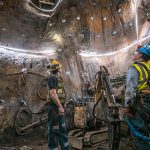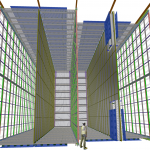From Brazilian Space, March 10, 2020: Durante a 5ª Comista, os dois países adotaram um Plano de Trabalho em Ciência e Tecnologia para o período de 2020 a 2023. Também foram firmados acordos de cooperação na área de cooperação científica em Física de Partículas de Alta Energia entre o Fermilab e a Fundação de Amparo à Pesquisa do Estado de São Paulo e outro acordo na mesma área entre o Fermilab e a Universidade de Campinas.
DUNE
From the U.S. Embassy and Consulates in Brazil, March 6, 2020: On March 5-6, Brazil and the United States held the fifth meeting of the Brazil-U.S. Joint Commission on Science and Technology Cooperation in Brasilia to deepen collaboration in key priority areas for the benefit of both countries. FAPESP and Fermilab signed an MOU to deepen scientific and technical cooperation in high-energy physics, and UNICAMP and Fermilab signed a cooperative agreement for a state-of-the-art LBNF cryogenics system.
From News at South Dakota State, Feb. 25, 2020: Two South Dakota State University professors are part of an international team of scientists and engineers working to uncover details about how the universe was formed. Stephen Gent and Greg Michna are using SDSU’s high-performance computing cluster to predict how argon circulates within the particle detectors to be constructed one mile beneath the earth’s surface. The detectors are for Fermilab’s Long-Baseline Neutrino Facility/Deep Underground Neutrino Experiment, which will be installed in the Sanford Underground Research Facility in Lead, South Dakota.
From Tunnels and Tunneling, Feb. 19, 2020: Three of the underground construction components are near completion at the Sanford Underground Research Facility for the far site of Fermilab’s Long-Baseline Neutrino Facility. Work is finishing up on two ore passes that connect the 4850 Level, almost one mile underground, to skips in the Ross Shaft; the Ross Headframe, which must support the skips that bring the rock to the surface; and the tramway tunnel, which will house the conveyor system that will transport excavated rock to its final location.
From Black Hills Pioneer, Feb. 19, 2020: Data from the Deep Underground Neutrino Experiment could help physicists explain the origin of matter, witness a never-before-seen particle decay and better understand how black holes form in space. To prepare for this groundbreaking science, a major construction project is under way to ready the Sanford Underground Research Facility for its role as the far site of Fermilab’s Long-Baseline Neutrino Facility.
From Labmate, Feb. 19, 2020: UK Research and Innovation representatives and the U.S. Department of Energy have signed an agreement outlining £65 million in contributions by UK research institutions and scientists to the international Deep Underground Neutrino Experiment and related projects hosted by Fermilab.
The publication of the Technical Design Report is a major milestone for the construction of the Deep Underground Neutrino Experiment, an international mega-science project hosted by Fermilab. It lays out in great detail the scientific goals as well as the technical components of the gigantic particle detectors of the experiment.
From University of Colima’s El Comentario, Feb. 4, 2020: Alexis Solís Ceballos, estudiante de Ingeniería Química Metalúrgica en la Facultad de Ciencias Químicas de la Universidad de Colima, participó recientemente en una estancia de tres meses en el Fermi National Accelerator Laboratory (Fermilab) de Estados Unidos, donde un grupo de científicos de todo el mundo explora las altas energías para responder preguntas fundamentales que ayudarían a entender mejor cómo funciona el universo.
From Cambridge Network, Feb. 3, 2020: Representatives from UK Research and Innovation and the US Department of Energy have signed an agreement that outlines £65 million worth of contributions that UK research institutions and scientists will make to the international Deep Underground Neutrino Experiment and related projects hosted by Fermilab. DUNE will study the properties of mysterious particles called neutrinos, which could help explain more about how the universe works and why matter exists at all.


